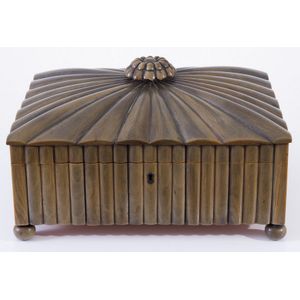Reeded Horn Sewing Box with Sandalwood Fittings
You must be a subscriber, and be logged in to view price and dealer details.
Subscribe Now to view actual auction price for this item
When you subscribe, you have the option of setting the currency in which to display prices to $Au, $US, $NZ or Stg.
- Ebony - Ebony is a close grained timber, black in colour. It has a fine texture which can be polished to a high gloss, making it suitable for venereering, inlay and stringing and its use as solid timber is resticted to small decorative items and ornamental decoration, such as chess pieces and musical instrument parts. The term "ebonised" means "faux ebony", timber that has been darkened during the polishing process to resemble ebony.
- Sandalwood - Sandalwood is a heavy, yellow coloured and very fine-grained timber, which has a fragrance which lasts for many decades, and acts as a deterent to moths and insects.
In the British colonial era, sandalwood was imported into Britain from India, and the wood also used within India for the manufacture of Anglo-Indian furniture.
Becasue it does not have a distinct grain pattern, sandalwood was not used for the exterior surfaces of furniture, but was put to use for drawer and box linings, where the aroma was noticeable one the object was opened. it was also used to manufacture small objects (treen).
Nowadays sandalwood is commercially grown with Australia the largest producer. As well as producing timber, oil is extracted for use in the manufacture of perfumes. - Finial - An architectural decoration, found on the upper parts of of an object. On furniture they are usually found on pediments, canopies and shelf supports. On smaller ceramic or silver items, such as spoons, they may decorate the top of the item itself, or the lid or cover where they provide a useful handle for removal.
Finials have a variety of shapes and forms. They may be urn-shaped, baluster shaped round or spiral, but usually taper into an upper point. Many real life shapes may also be used as finials, such as pineapples, berries, pinecones, buds, lotus and acorns. Sometimes animals such as a lion are depicted, or fish and dolphins.
This item has been included into following indexes:
Visually similar items

A large antique Indian metal bound Dowry chest on wheels, with an arched top with dual heavy metal engraved locks, riveted strapwork with embossed patterned borders and serrated edging, rosette studwork to the front, raised on timber wheels hidden behind s

Carved oriental altar table, with 2 drawers and 2 doors, 126 cm wide, 46 cm deep, 80 cm high

Schulim Krimper (Australian, 1893-1971), Blanket Chest, c. 1960, probably Queensland walnut, of plain design with exposed dovetail corners, raised on two feet, hammered horse shoe brass pulls, locks and keys, two keys available, height cm, width cm, depth

Pine single door cupboard, made from packing crate boards, retaining original paint, with two interior shelves and swing door, height 114 cm width 47 cm depth 48 cm. Provenance: The Estate of Ray Hughes
